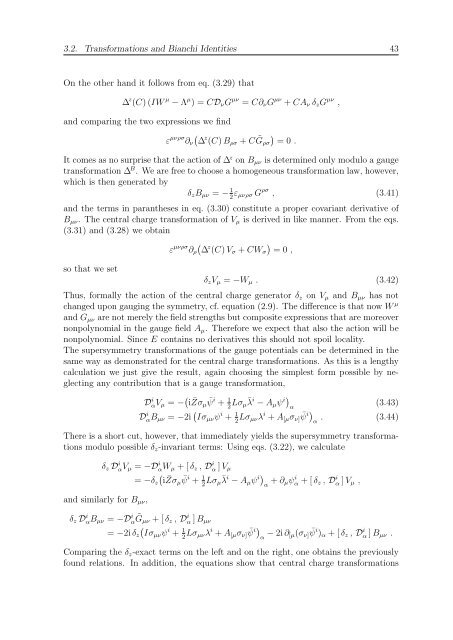N=2 Supersymmetric Gauge Theories with Nonpolynomial Interactions
N=2 Supersymmetric Gauge Theories with Nonpolynomial Interactions
N=2 Supersymmetric Gauge Theories with Nonpolynomial Interactions
You also want an ePaper? Increase the reach of your titles
YUMPU automatically turns print PDFs into web optimized ePapers that Google loves.
3.2. Transformations and Bianchi Identities 43<br />
On the other hand it follows from eq. (3.29) that<br />
∆ z (C) (IW µ − Λ µ ) = CDνG µν = C∂νG µν + CAν δzG µν ,<br />
and comparing the two expressions we find<br />
ε µνρσ z<br />
∂ν ∆ (C) Bρσ + C ˜ <br />
Gρσ = 0 .<br />
It comes as no surprise that the action of ∆z on Bµν is determined only modulo a gauge<br />
transformation ∆B . We are free to choose a homogeneous transformation law, however,<br />
which is then generated by<br />
δzBµν = − 1<br />
2εµνρσ G ρσ , (3.41)<br />
and the terms in parantheses in eq. (3.30) constitute a proper covariant derivative of<br />
Bµν. The central charge transformation of Vµ is derived in like manner. From the eqs.<br />
(3.31) and (3.28) we obtain<br />
ε µνρσ z<br />
∂ρ ∆ (C) Vσ + CWσ = 0 ,<br />
so that we set<br />
δzVµ = −Wµ . (3.42)<br />
Thus, formally the action of the central charge generator δz on Vµ and Bµν has not<br />
changed upon gauging the symmetry, cf. equation (2.9). The difference is that now W µ<br />
and Gµν are not merely the field strengths but composite expressions that are moreover<br />
nonpolynomial in the gauge field Aµ. Therefore we expect that also the action will be<br />
nonpolynomial. Since E contains no derivatives this should not spoil locality.<br />
The supersymmetry transformations of the gauge potentials can be determined in the<br />
same way as demonstrated for the central charge transformations. As this is a lengthy<br />
calculation we just give the result, again choosing the simplest form possible by neglecting<br />
any contribution that is a gauge transformation,<br />
D i αVµ = − i ¯ Zσµ ¯ ψ i + 1<br />
2Lσµ ¯ λ i − Aµψ i<br />
α<br />
D i αBµν = −2i Iσµνψ i + 1<br />
2Lσµνλ i + A[µσν] ¯ ψ i<br />
α<br />
(3.43)<br />
. (3.44)<br />
There is a short cut, however, that immediately yields the supersymmetry transformations<br />
modulo possible δz-invariant terms: Using eqs. (3.22), we calculate<br />
δz D i αVµ = −D i αWµ + [ δz , D i α ] Vµ<br />
<br />
= −δz iZσµ ¯ ¯ ψ i + 1<br />
2Lσµ ¯ λ i − Aµψ i<br />
α + ∂µψ i α + [ δz , D i α ] Vµ ,<br />
and similarly for Bµν,<br />
δz D i αBµν = −D i α ˜ Gµν + [ δz , D i α ] Bµν<br />
<br />
= −2i δz Iσµνψ i + 1<br />
2Lσµνλ i + A[µσν] ¯ ψ i<br />
α − 2i ∂[µ(σν] ¯ ψ i )α + [ δz , D i α ] Bµν .<br />
Comparing the δz-exact terms on the left and on the right, one obtains the previously<br />
found relations. In addition, the equations show that central charge transformations

















